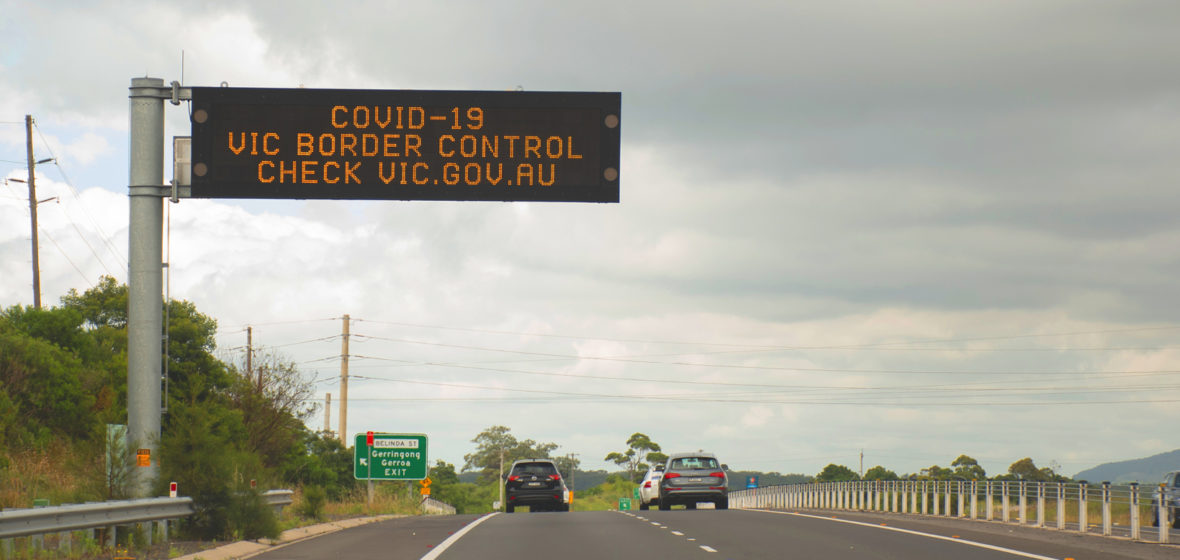As Australia’s COVID-19 vaccination rate edges closer to 80 per cent, how long can states keep their borders shut, legally?
“We’ll do what we need to do to protect ourselves, we’re not going to get into some of that mad bullying that’s going on out of Sydney and the Liberal Party.”
This was WA Premier Mark McGowan’s response in September to journalists asking when his state’s hard border would come down after months of closures. It’s just one example of the war playing out over state lines that has become a hallmark of Australia’s COVID-19 experience.
Premiers have been derided or praised (usually depending which side of border lines commentators fall) for lowering iron curtains around their states to prevent the spread of COVID-19. Health systems – which are managed by state jurisdictions – need protection, they have said. Some have won favour with their own constituents in chasing zero-COVID transmission.
But as a zero-COVID goal becomes increasingly unlikely, and vaccination rates trend upwards as we approach 2022, how long can these lines continue to divide Australians?
The constitutional issues at play
Border closures between states are extraordinary by historic measures. Indeed, when the Victoria-NSW border shut in July 2020, it represented the first time those states were divided in 100 years. Previously it had been shut in 1919 during the Spanish flu pandemic, which killed about 15,000 Australians. At the time of writing, 1300 Australians have died with COVID-19.
The political minds behind the push to federation in 1901 apparently did not envision border closures, either. In the process of drafting the constitution in the 1890s, Sir Henry Parkes said, “an absolutely necessary condition” of federation was “Australia shall be free – free on borders, free everywhere”.
With this in mind, mining magnate Clive Palmer launched a High Court challenge to WA’s hard border last year. He claimed it breached section 92 of the Australian Constitution, which guarantees Sir Parkes’ vision of free “trade, commerce and intercourse” between the states. Palmer was unsuccessful as the High Court ruled WA’s emergency health orders instating border closures, at the time, were proportionate to protecting health and livelihoods of Australian citizens. But plenty can change in one year.
Since Palmer’s unsuccessful campaign against McGowan, vaccines have been developed and distributed widely. Some states have vaccinated more than 70 per cent of their adult populations. It’s why Federal Attorney-General Michaelia Cash, a senator from WA, recently warned that the border restrictions are “no longer necessary and proportionate”.
Fresh facts beg the question: would a fresh challenge to the border closures succeed?

How the High Court decides
Flight Centre chief executive Graham Turner recently threatened that his company was preparing a new challenge to bring to the High Court over the WA border closures. Australian Chamber of Tourism chair John Hart has confirmed the challenge would find support among many other businesses.
“Our lawyers do believe the case has actually changed since the Palmer case on whether it is reasonable to keep the borders shut,” Turner told News Corp in September.
UNSW Law Professor and Constitutional law expert Gabriele Appleby tells LSJ the constitution does not explicitly give states power to shut their borders. They have power to create laws – such as emergency laws to shut borders in a health crisis – but the constitution stipulates limits to those powers.
“Rather than a question about the power of states, it’s a question about whether there are any limitations on those powers,” she says. “So, the question becomes – what are those limits?”
“Our concern all along has been to make sure that any public health measures, including border closures, are proportionate to the actual threat posed by the pandemic.”
Section 92 sets out a limit on state power to closing state borders by guaranteeing free trade, commerce, and intercourse between states. However, in an unprecedented health crisis like the COVID-19 pandemic, states may be justified in taking extraordinary measures.
“The outcome of the Palmer challenge did very much turn on the facts as they were last year when the challenge was brought,” Appleby says.
“That gives rise to the question: if the situation changes, such that we do have higher vaccination rates and a more highly vaccinated population, are there more reasonable alternatives open to the states [other than border closures] – such that you can’t justify a tight border closure? Would the High Court uphold a challenge in those changed circumstances?”
Crucially, Chief Justice Kiefel and Justice Keane offered this reasoning in their decision in 2020: “There is no known vaccine, and no treatment presently available to mitigate the risks of severe medical outcomes or mortality for a person who contracts COVID-19.”
It appears to leave the door open to fresh High Court challenges. However, Appleby says it is by no means certain how a new case would play out.
“I long ago decided I would never predict what the High Court was going to do,” she says. “What we do know about section 92 cases is the court is highly fact-specific. So, those changing facts would be considered in depth by the court.
“But we also know that the court is very cautious about second guessing policy responses by the government. I think particularly in a time of health crisis, they would be reluctant to do so.”
The impact on freedom and civil liberties
Families separated across state lines and individuals accessing medical treatment in different states have suffered sad, at times tragic, consequences due to Australia’s internal border closures. Appleby warns that restrictions on movement also potentially reduce Australians’ abilities to freely communicate, gather and congregate on political issues – restricting the freedom of political communication that is implied under the constitution and has been confirmed by the High Court in a handful of cases since the 1990s.
President of the NSW Council for Civil Liberties, Pauline Wright, says the length of time that Australians have had their freedom of movement curbed is a threat to democracy and civil liberties. As COVID-19 vaccination rates rise, she says the measures become less proportionate to the risk.
“Our concern all along has been to make sure that any public health measures, including border closures, are proportionate to the actual threat posed by the pandemic,” she says.

“When you’ve got vaccination rates up at 70 and 80 per cent, the risk posed by the pandemic is so much less severe. Much less severe than before people got vaccinated. The government responses then have to proportionately be reduced; restrictions on our liberties have to be reduced.
“It’s pretty alarming to hear that that QLD and others are saying we’re not going to open the borders until after Christmas. I think that’s actually quite disturbing … it’s really going to put pressure on governments, and I think it’s incredibly unwise.”
Wright points to the dramatic protests that have besieged Melbourne recently as evidence of a mood among some Australians that government restrictions are becoming too heavy-handed to continue.
“The civil unrest that we’ve seen, for instance, in Melbourne, is just going to increase if measures are not proportionately wound back. Because people lose faith in the fairness of the measures that are being taken,” she says.
“People are really sensitive to nuances in the balance between safety and their liberties. When you’ve got NSW saying, in this number of weeks this is going to happen, in two weeks this is going to happen. If those borders don’t open up, there’s going to be an atmosphere of … you’ve been telling us to vaccinate, we’ve done what you said, that’s not fair, that’s not the deal.”
Whether and when Australia’s interstate borders will come down via premiers capitulating or a High Court challenge is just one more unknown of the COVID-19 pandemic. One thing that seems clear is the political war of words becoming almost as endemic as the disease.




